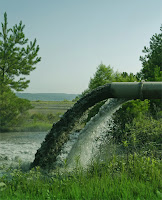Many Ohio residents drink their water from the
ground or through private water systems. Water must be tested to avoid any
lingering bacteria which could harm the human body. Coliform, turbidity, radon,
cryptosporidium, giardia, and harmful algal bloom cyanotoxins can all
contaminate drinking water. Each bacterium can be found in some form of water.
Whether the water is ground water, aquifers/ personal wells, or surface water,
lakes/ ponds.
Coliform is known as a
microorganism that lives in soil, plants, and the human intestine. A common
specie of coliform is E. coli. A person can come in contact with this
microorganism by drinking or consuming it. Symptoms of coliform can range from
no symptoms to cramps or diarrhea. An easy way to prevent yourself from
contamination is to clean the area around or in your water source. The standard
for Coliform is 0 MCL.
 |
| https://www.pacelabs.com/environmental-services/field-services/water-quality-monitoring.html |
Turbidity is also known
as the level of cloudiness in the water. It typical arouses
from the movement of water through soil into someone’s ground water supply.
Health risks of turbidity include headaches, diarrhea and more. If you suspect
that your water is cloudy, install a water filter to help clean the water
fully. Turbidity standards are not noticed until it reaches 5 MCL, however, it
should be lower for safe drinking water.
Radon is a gaseous
element that can be contaminating a water supply. It can dissolve and
contaminate only into ground water, but not surface water. Radon in drinking
water can cause cancer or even death. A way to check for radon in your water
would be to figure out if the water comes from the ground or surface. The
standard for safe drinking is 5 MCL.
 |
| https://www.allianceforthebay.org/2015/12/renewed-commitment-to-volunteer-water-quality-monitoring-in-virginia/ |
Cryptosporidium is a
microscopic parasite which is a diarrheal disease. The parasite is transported
through fecal matter. Any water that can be contaminated by fecal matter is at
risk of having cryptosporidium. If someone suspects that their water has been
contaminated, then they can contact their state certified officer to have them
come clean the water. If they chose to take care of it themselves, they should
boil the water for at least a minute and let cool before consuming. The
standard for cryptosporidium is 0 MCL.
Giardia is also a microscopic parasite that
can linger in someone’s water. It is passed through fecal matter of an infected
human or animal. Eating or drinking anything that has been come in contact with
giardia will become contaminated so a person should avoid those products.
Symptoms of contamination in humans include diarrhea, upset stomach and
more. The drinking water standard is also 0 MCL.
 |
| http://www.agriculture.gov.au/water/quality |
Harmful Algal Bloom
(HBA) Cyanotoxins is a type of bacteria that can be found in lakes, ponds, or
shallow bodies of water. People can come in contact with this bacteria by
drinking it, skin contact, and inhaling. Symptoms include rashes, sore throat,
diarrhea, or vomiting. Prevention could include rinse off your body with clean
fresh water. The drinking water standard for HBA Cyanotoxin is 0 MCL.